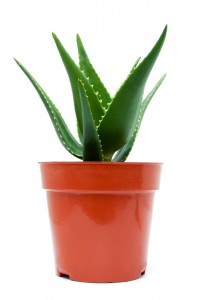The Egyptians called it the “Plant of Immortality” and beauties like Nefertiti and Cleopatra depended on aloe vera for smooth, wrinkle-free skin. Alexander the Great and Christopher Columbus always had aloe handy to treat wounds on the battlefield, and in the mid-1930s doctors discovered that aloe successfully healed chronic and severe radiation dermatitis.
With 75 active constituents, including antioxidant vitamins and minerals, amino acids, and enzymes, aloe vera is a must-have component of your skincare. You can use it as an overall skin beautifier, or to treat insect bites, skin allergies and rashes, acne, sun damage…there’s no end to what aloe can do! While you can certainly buy a gel preparation, why not go directly to the source and soothe skin with aloe fresh from cut aloe leaves? Aloe vera plants are easy to care for (it’s much easier to overwater than underwater them)…all you need is a pot and some cactus mix!
 Aloe Vera for Hydration and Protection
Aloe Vera for Hydration and Protection
Aloe vera is rich in the primary skin vitamins A, C, and E, as well as B12, folic acid, and choline. These antioxidants protect against free-radical-induced skin damage and help to improve elasticity and firmness by keeping skin hydrated and boosting collagen synthesis. Glucomannan (a polysaccharide) and gibberellin (a growth hormone) influence receptors on fibroblasts—the active cells of the skin’s connective tissue. These fibroblasts in turn stimulate collagen, elastin, and hyaluronic acid production, thereby improving skin firmness and smoothness.
Aloe vera features a long sugar molecule chain called mucopolysaccharides that locks moisture into the skin. The moisture boost is also due to aloe vera’s high concentration of amino acids, which soften hardened skin cells. And, it’s moisturizing without leaving behind a film of greasiness and helps to restore the skin’s natural pH balance.
Researchers at Northwestern University put the softening properties of aloe vera to the test by focusing on the hands—one of the first skin surface areas to succumb to the visible signs of aging. Thirty female factory assembly line workers with dry, chaffed hands each wore a glove containing aloe vera gel for 30 days. After 3.5 days, the skin on their hands showed significant improvement…and after 10 days between 90-100% improvement!
Aloe Vera for Problematic Skin Conditions
Aloe vera has the 3 As!
- Antiseptic
- Antibacterial
- Anti-inflammatory
Perfect for sensitive skins, the aloe vera plant can heal eczema, psoriasis, itchy skin, blisters, insect bites, and allergic reactions. Saponins, which constitute approximately 3% of aloe vera gel, are antiseptic in nature, and salicylic acid is both antibacterial and anti-inflammatory. Auxins and gibberellin hormones work alongside the enzyme bradykinase and the compound C-glucosyl chromone to calm inflamed, red skin, be it from acne or wounds.
Using the Aloe Vera Plant
Extract some aloe vera gel from your plant using the following steps:
- Cut an aloe leaf from your plant using a sharp knife. Rinse the leaf to make sure it’s free of microbes.
- Cut off about two inches from the base of the plant and store the remaining aloe vera leaf upright in a jar.
- Cut off the green skin on the flat side of the leaf and scoop out the gel inside with a spoon. Apply to skin for an aloe vera facial!




